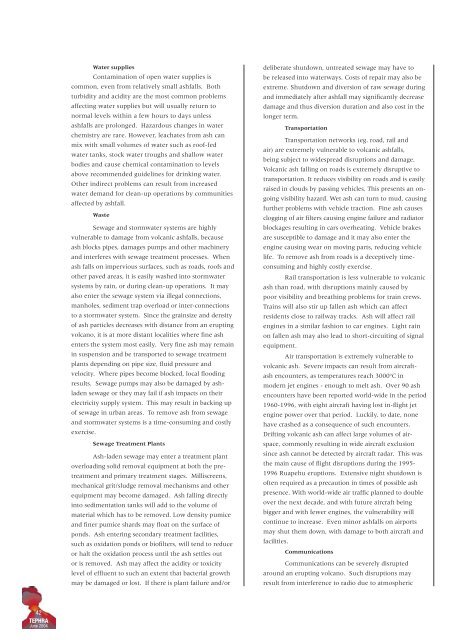Volcanoes - Ministry of Civil Defence and Emergency Management
Volcanoes - Ministry of Civil Defence and Emergency Management
Volcanoes - Ministry of Civil Defence and Emergency Management
Create successful ePaper yourself
Turn your PDF publications into a flip-book with our unique Google optimized e-Paper software.
Water supplies<br />
Contamination <strong>of</strong> open water supplies is<br />
common, even from relatively small ashfalls. Both<br />
turbidity <strong>and</strong> acidity are the most common problems<br />
affecting water supplies but will usually return to<br />
normal levels within a few hours to days unless<br />
ashfalls are prolonged. Hazardous changes in water<br />
chemistry are rare. However, leachates from ash can<br />
mix with small volumes <strong>of</strong> water such as ro<strong>of</strong>-fed<br />
water tanks, stock water troughs <strong>and</strong> shallow water<br />
bodies <strong>and</strong> cause chemical contamination to levels<br />
above recommended guidelines for drinking water.<br />
Other indirect problems can result from increased<br />
water dem<strong>and</strong> for clean-up operations by communities<br />
affected by ashfall.<br />
Waste<br />
Sewage <strong>and</strong> stormwater systems are highly<br />
vulnerable to damage from volcanic ashfalls, because<br />
ash blocks pipes, damages pumps <strong>and</strong> other machinery<br />
<strong>and</strong> interferes with sewage treatment processes. When<br />
ash falls on impervious surfaces, such as roads, ro<strong>of</strong>s <strong>and</strong><br />
other paved areas, it is easily washed into stormwater<br />
systems by rain, or during clean-up operations. It may<br />
also enter the sewage system via illegal connections,<br />
manholes, sediment trap overload or inter-connections<br />
to a stormwater system. Since the grainsize <strong>and</strong> density<br />
<strong>of</strong> ash particles decreases with distance from an erupting<br />
volcano, it is at more distant localities where fine ash<br />
enters the system most easily. Very fine ash may remain<br />
in suspension <strong>and</strong> be transported to sewage treatment<br />
plants depending on pipe size, fluid pressure <strong>and</strong><br />
velocity. Where pipes become blocked, local flooding<br />
results. Sewage pumps may also be damaged by ashladen<br />
sewage or they may fail if ash impacts on their<br />
electricity supply system. This may result in backing up<br />
<strong>of</strong> sewage in urban areas. To remove ash from sewage<br />
<strong>and</strong> stormwater systems is a time-consuming <strong>and</strong> costly<br />
exercise.<br />
Sewage Treatment Plants<br />
Ash-laden sewage may enter a treatment plant<br />
overloading solid removal equipment at both the pretreatment<br />
<strong>and</strong> primary treatment stages. Milliscreens,<br />
mechanical grit/sludge removal mechanisms <strong>and</strong> other<br />
equipment may become damaged. Ash falling directly<br />
into sedimentation tanks will add to the volume <strong>of</strong><br />
material which has to be removed. Low density pumice<br />
<strong>and</strong> finer pumice shards may float on the surface <strong>of</strong><br />
ponds. Ash entering secondary treatment facilities,<br />
such as oxidation ponds or bi<strong>of</strong>ilters, will tend to reduce<br />
or halt the oxidation process until the ash settles out<br />
or is removed. Ash may affect the acidity or toxicity<br />
level <strong>of</strong> effluent to such an extent that bacterial growth<br />
may be damaged or lost. If there is plant failure <strong>and</strong>/or<br />
deliberate shutdown, untreated sewage may have to<br />
be released into waterways. Costs <strong>of</strong> repair may also be<br />
extreme. Shutdown <strong>and</strong> diversion <strong>of</strong> raw sewage during<br />
<strong>and</strong> immediately after ashfall may significantly decrease<br />
damage <strong>and</strong> thus diversion duration <strong>and</strong> also cost in the<br />
longer term.<br />
Transportation<br />
Transportation networks (eg. road, rail <strong>and</strong><br />
air) are extremely vulnerable to volcanic ashfalls,<br />
being subject to widespread disruptions <strong>and</strong> damage.<br />
Volcanic ash falling on roads is extremely disruptive to<br />
transportation. It reduces visibility on roads <strong>and</strong> is easily<br />
raised in clouds by passing vehicles. This presents an ongoing<br />
visibility hazard. Wet ash can turn to mud, causing<br />
further problems with vehicle traction. Fine ash causes<br />
clogging <strong>of</strong> air filters causing engine failure <strong>and</strong> radiator<br />
blockages resulting in cars overheating. Vehicle brakes<br />
are susceptible to damage <strong>and</strong> it may also enter the<br />
engine causing wear on moving parts, reducing vehicle<br />
life. To remove ash from roads is a deceptively timeconsuming<br />
<strong>and</strong> highly costly exercise.<br />
Rail transportation is less vulnerable to volcanic<br />
ash than road, with disruptions mainly caused by<br />
poor visibility <strong>and</strong> breathing problems for train crews.<br />
Trains will also stir up fallen ash which can affect<br />
residents close to railway tracks. Ash will affect rail<br />
engines in a similar fashion to car engines. Light rain<br />
on fallen ash may also lead to short-circuiting <strong>of</strong> signal<br />
equipment.<br />
Air transportation is extremely vulnerable to<br />
volcanic ash. Severe impacts can result from aircraftash<br />
encounters, as temperatures reach 3000 o C in<br />
modern jet engines - enough to melt ash. Over 90 ash<br />
encounters have been reported world-wide in the period<br />
1960-1996, with eight aircraft having lost in-flight jet<br />
engine power over that period. Luckily, to date, none<br />
have crashed as a consequence <strong>of</strong> such encounters.<br />
Drifting volcanic ash can affect large volumes <strong>of</strong> airspace,<br />
commonly resulting in wide aircraft exclusion<br />
since ash cannot be detected by aircraft radar. This was<br />
the main cause <strong>of</strong> flight disruptions during the 1995-<br />
1996 Ruapehu eruptions. Extensive night shutdown is<br />
<strong>of</strong>ten required as a precaution in times <strong>of</strong> possible ash<br />
presence. With world-wide air traffic planned to double<br />
over the next decade, <strong>and</strong> with future aircraft being<br />
bigger <strong>and</strong> with fewer engines, the vulnerability will<br />
continue to increase. Even minor ashfalls on airports<br />
may shut them down, with damage to both aircraft <strong>and</strong><br />
facilities.<br />
Communications<br />
Communications can be severely disrupted<br />
around an erupting volcano. Such disruptions may<br />
result from interference to radio due to atmospheric<br />
42<br />
TEPHRA<br />
June 2004

















